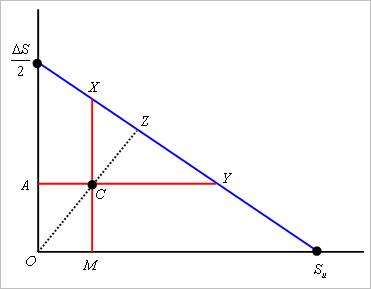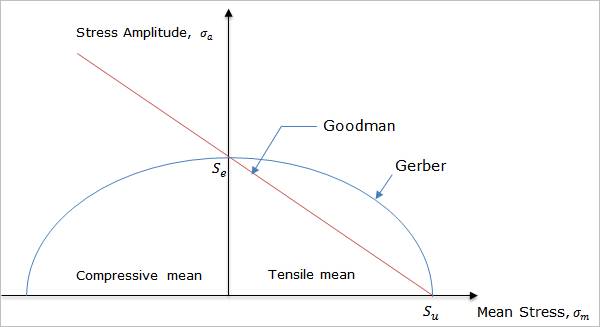
The user can use fatigue safety factor to evaluate fatigue strength and predict whether any part of the structure will ever fail in the design life due to cyclic loading in an event. RecurDyn/Durability supports the Goodman, Gerber and Modified Goodman methods.
Goodman & Gerber
The calculation method for the safety factor (SF) is as follows:
•Both stress amplitude and mean stress are varying:
•Goodman: 
•Gerber: 
where
 ∶ Normal strain amplitude for a
cycle
∶ Normal strain amplitude for a
cycle
 ∶ Bi-axiality ratio
∶ Bi-axiality ratio
 ∶ Mean stress for a cycle
∶ Mean stress for a cycle
 ∶ Ultimate tensile strength
(material property)
∶ Ultimate tensile strength
(material property)
 ∶ Fatigue strength limit
∶ Fatigue strength limit
Here, i represents time step. If uni-axial is selected in
life criteria type, bi-axiality ratio ( ) should be 0.
) should be 0.
In order to explain the safety factor concept with the schematic diagram, the Goodman is used for an example.
For the Goodman method, the user can draw below the schematic diagram.

Figure 1 A schematic diagram for safety factor of Goodman.
And the safety factor can be calculated as follows:
•Both stress amplitude and mean stress are varying:
SF = OZ/OC
Where,
 ∶ Identified stress cycle
∶ Identified stress cycle
 ∶ Mean stress of the cycle
∶ Mean stress of the cycle
 ∶ Stress amplitude of the
cycle
∶ Stress amplitude of the
cycle
 ∶ Ultimate tensile strength
(material property)
∶ Ultimate tensile strength
(material property)
 ∶ Fatigue strength limit or the
endurance limit(Se)
∶ Fatigue strength limit or the
endurance limit(Se)
When applying the compressive means stress to a specimen, the safety factor results should be different as shown below figure 2.
Especially, in case of using Goodman method, the safety factor will increase if the compressive mean stress exists in the element free face.

Figure 2 Comparison of two safety factor methods considering the compressive mean stress
Note
In order to calculate two Safety Factor types such as Goodman and Gerber, two parameters should be needed in the material properties. These are the Ultimate Tensile Strength and the Fatigue Strength Limit. At that time, if there is no the Fatigue Strength Limit information in material properties, the durability solver can be used the Cyclic Strength Coefficient in material properties instead of that.
Modified Goodman
In the case of Modified Goodman method, Haigh diagram is as shown in the Figure 3 below.

Figure 3 Haigh diagram for Modified Goodman method
Here,
 ∶ Yield strength (material
property)
∶ Yield strength (material
property)
 ∶ Ultimate tensile strength
(material property)
∶ Ultimate tensile strength
(material property)
 ∶ Fatigue strength limit or the
endurance limit (Se)
∶ Fatigue strength limit or the
endurance limit (Se)
Unlike the Goodman method, this method can consider the yield strength of the selected material when calculating the safety factor as the upper figure. This can be called as an Augmented Modified-Goodman Diagram. At that time, this method supports only the material of which Cyclic Yield Strength or Fatigue Limit Stress should be less than Yield Stress. So, if the warning message has occurred when applying this method, the Fatigue Limit Stress should be defined less than the Yield Strength in the selected material property.
User-Defined Haigh diagram
When a User-Defined Haigh diagram is selected, it is possible to describe the Augmented Modified-Goodman Diagram as written by at least 5 points. At this point, the user has to know exactly the position composed of the Mean stress vs. Stress amplitude instead of three components such as Sy, Su and Se.
So, if the information related to the Mean stress vs. Stress amplitude, it is possible to draw a Haigh diagram as the user wants instead of the defined criteria such as Goodman, Gerber and Modified Goodman.